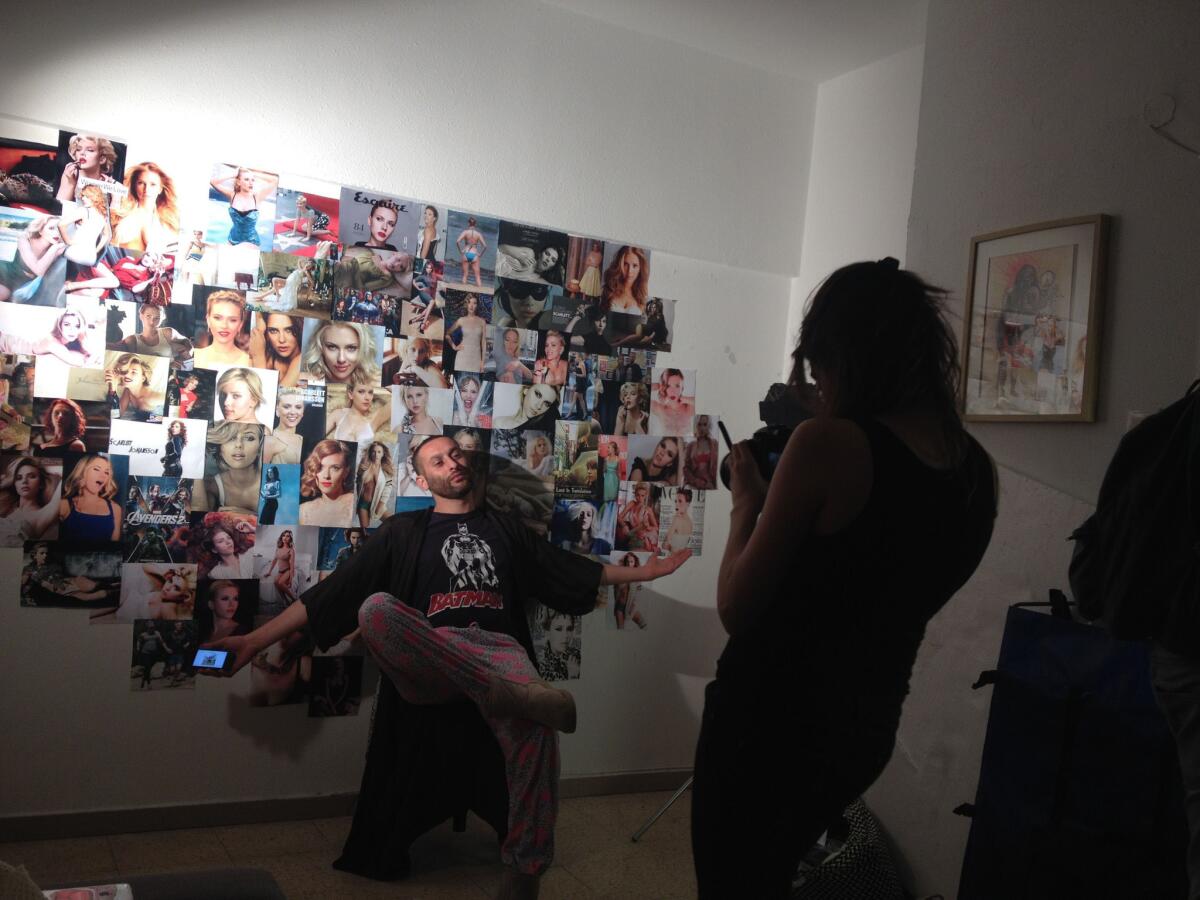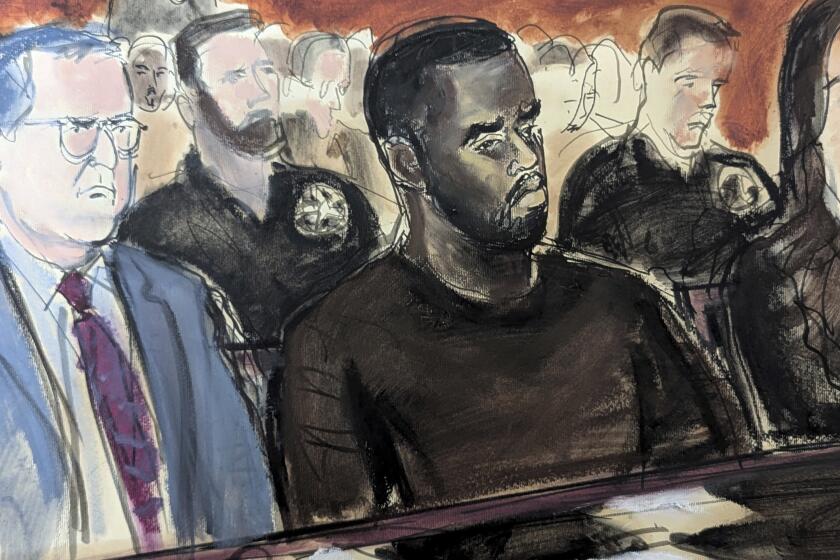Palestinian rapper Tamer Nafar aims for a global stage

- Share via
TEL AVIV — Tamer Nafar, a 34-year-old rapper who has been described as the Chuck D of Palestinian hip-hop, was standing on a sidewalk dressed in a skin-tight black bodysuit and wearing a silky red wig.
“Can I see more duck lips?” the director prodded from behind the camera. Nafar pursed obediently.
FOR THE RECORD:
Tamer Nafar: A profile of Palestinian rapper Tamer Nafar in the April 13 Arts and Books section said that SodaStream, a company that manufactures beverage carbonation machines, was headquartered in an Israeli settlement in the West Bank. The company has a factory in the West Bank but is headquartered in Lod, Israel.
He was channeling Scarlett Johansson for a video sketch skewering the actress for serving as a spokeswoman for SodaStream, a company boycotted by Palestinian activists because it is headquartered in an Israeli settlement in the West Bank.
PHOTOS: 2013’s year of controversial rap lyrics
Over the years, Nafar and DAM, the hip-hop trio he founded in the late 1990s with his brother Suhell and their friend Mahmoud Jreri, have produced dozens of searing songs about the Israeli-Palestinian conflict. But this was the first time Nafar had cross-dressed for the cause. When a gaggle of teenagers stopped to catcall, the rapper rolled his eyes and shouted, “Oh, stop!”
Nafar, a Palestinian citizen of Israel, has undergone a vivid transformation since his teenage years in the nightclubs of Tel Aviv, where he got his start rapping in Hebrew under the wing of a Zionist Jewish MC. Politicized during the Second Intifada, Nafar denounced his mentor, shifted to Arabic and gave voice to a generation of young, disaffected Palestinians on both sides of the green line.
Ask young rappers in the West Bank or the Gaza Strip whom they look up to and they will name Nafar — and then start shouting his rhymes. But life as a Palestinian artist isn’t easy. Unlike the vibrant Israeli music scene, there are few record labels and concert promoters catering to Palestinian performers.
DAM, which means “blood” in Arabic, self-released its most recent album, and some of the projects Nafar works on, like an upcoming documentary video project to chronicle the life of kids in East Jerusalem, are funded by nongovernmental organizations.
The growing popularity of the Boycott, Divestment and Sanctions movement, which limits Palestinian collaborations with Israeli academics and artists, has made things more difficult. Nafar supports the movement, but adhering to its principles means he sometimes turns down paying gigs.
“When we get invited to play a show, we don’t send a rider with our technical specifications,” he said. “We ask, ‘Is it political? Are there Zionist bands involved? It is so exhausting.”
Nafar, whose quick wit and cocky style got him into fights as a teenager, has mellowed with marriage and fatherhood. He’d like to move his wife and two sons out of Lod, the gritty Tel Aviv suburb where he grew up, but he doesn’t have the money to do so yet.
The dream of more economic opportunities is one reason he is working hard to expand his reach to a global audience. This year he plans to star in a film based loosely on his life and finish recording his first English-language solo record; to bone up on new vocabulary, he’s been reading an English dictionary one page at a time.
But there is another motivation, part creative challenge and part hubris. Like every celebrated rapper, Nafar is both self-confident and self-conscious, and he’s terrified of being pigeonholed as a niche Palestinian MC. He isn’t satisfied with the 300,000 views that the most recent DAM music video chalked up on YouTube. “I can kill it in any language,” he said. “I want the world.”
Hip-hop beginnings
On a blustery late winter morning, Nafar drove through Lod in his small hatchback, a beanie pulled low over his ears and a song from the New Zealand pop star Lorde bumping from his speakers.
Lod, which lies in the flight path of nearby Ben Gurion International Airport, is known as the site of a major railway depot, as the capital of Israel’s drug trade, and not much else. Nafar’s family ended up here during the 1948 Arab-Israeli war after being expelled from the nearby city of Yaffa. Many Palestinians ended up farther away, in neighboring Arab countries or the territories of the West Bank and the Gaza Strip.
PHOTOS: 10 great rap lyrics of 2013
Nafar parked outside of a dingy complex of concrete apartment buildings, where surveillance cameras were attached to light posts and graffiti marred the walls .
“This is where Palestinian hip-hop started,” he said, pointing to the second-story unit where he grew up. “I used to play Tupac 24 hours a day.”
Nafar was 17 when he started rapping about the drugs and crime he saw in his neighborhood. With the support of his father, himself a former musician, Nafar recruited his younger brother and their neighbor to form a band.
Hip-hop spoke to Nafar, who compares the plight of the 1.7 million Palestinians living inside Israel to that of African Americans in the U.S. But it wasn’t until after the collapse of the 2000 Camp David accords and the outbreak of the Second Intifada, or Palestinian uprising, that he embraced a political message in his own music.
With Palestinian suicide bombers blowing up Israeli buses and cafes and Israeli security forces cracking down on Palestinians, including on Palestinian citizens inside Israel, Nafar felt like he had to pick a side.
On DAM’s polarizing 2001 track “Who’s the Terrorist?” Nafar blames Israel for the problems, seething: “You’ve raped the Arab soul/ and it became pregnant, giving birth to a child called ‘terror attack.’”
FACES TO WATCH 2014: Pop music & jazz
The song cost him his friendship with a Jewish rapper known as Subliminal, who had helped Nafar get established on the Israeli hip-hop scene and who adopted an increasingly more patriotic tone as the Intifada wore on.
But it made DAM superstars among the Palestinian diaspora and those sympathetic to the Palestinian cause.
The group’s songs, typically built around samples of traditional Middle Eastern string instruments with a chorus sung by a female vocalist, were among the first to feature Arabic raps.
Nafar remembers the group’s first show before a Palestinian audience and the thousands of fans singing along. “It was like 2,000 people telling you you belong here,” he said.
American hip-hop artists reached out. Several world tours followed. And across the region young Palestinians started dressing in baggy clothes and picking up mikes. Today there are dozens of Palestinian rap groups inside Israel and in the West Bank and Gaza.
Fight against injustice
Udi Aloni, an Israeli American film director making the film about Nafar’s life,credits him and DAM with forging a pan-Palestinian identity through hip-hop. “They reconnected these parts that Israel dismembered,” said Aloni, who worked on the video for DAM’s seminal 2005 anti-occupation anthem “Born Here,” in which Nafar spits rhymes in the face of armed Israeli police.
Nafar was arrested during the shoot. After he was released, he and a female Palestinian singer who had appeared in the video said they were harassed by her relatives, who said she had brought shame on the family.
The experience prompted him to widen his critique beyond Israel to take on aspects of Palestinian society. “When the cops dropped me, society picked me up,” said Nafar. Last year he wrote a song criticizing so-called honor killings of women that was released as part of a U.N. campaign against the practice. Nafar, who has also spoken out against homophobia in Arab culture, said he learned from the incident that his battle was not against “Jews or Israelis” but against injustice anywhere.
Nafar and DAM have drawn criticism from supporters of Israel. A DAM performance at a high school in Oregon was boycotted, with local Christian groups accusing the rappers of “justifying terrorism” against Israelis by demonizing them as rapists and Nazis.
In Israel, Nafar often collaborates with Jews who support the Palestinian cause. One of them, Aviva Zimmerman, directed the Scarlett Johansson video, and she and Nafar kept up a playful banter throughout the shoot. After one directing prompt, he responded: “I’ll do anything for you because you are more superior than us in culture and everything.”
Filming lasted eight hours. By the end everybody was dragging, and when Zimmerman called out directions for the last scene, Nafar collapsed onto the ground, feigning a heart attack.
“Put your hand here, please,” he said, clutching his chest. “I think I’m dying.”
Zimmerman prodded him to his feet. “Come on,” she told him. “You said you wanted to be a hip-hop star.”
More to Read
The biggest entertainment stories
Get our big stories about Hollywood, film, television, music, arts, culture and more right in your inbox as soon as they publish.
You may occasionally receive promotional content from the Los Angeles Times.











